1995 GMC SIERRA ignition
[x] Cancel search: ignitionPage 39 of 488
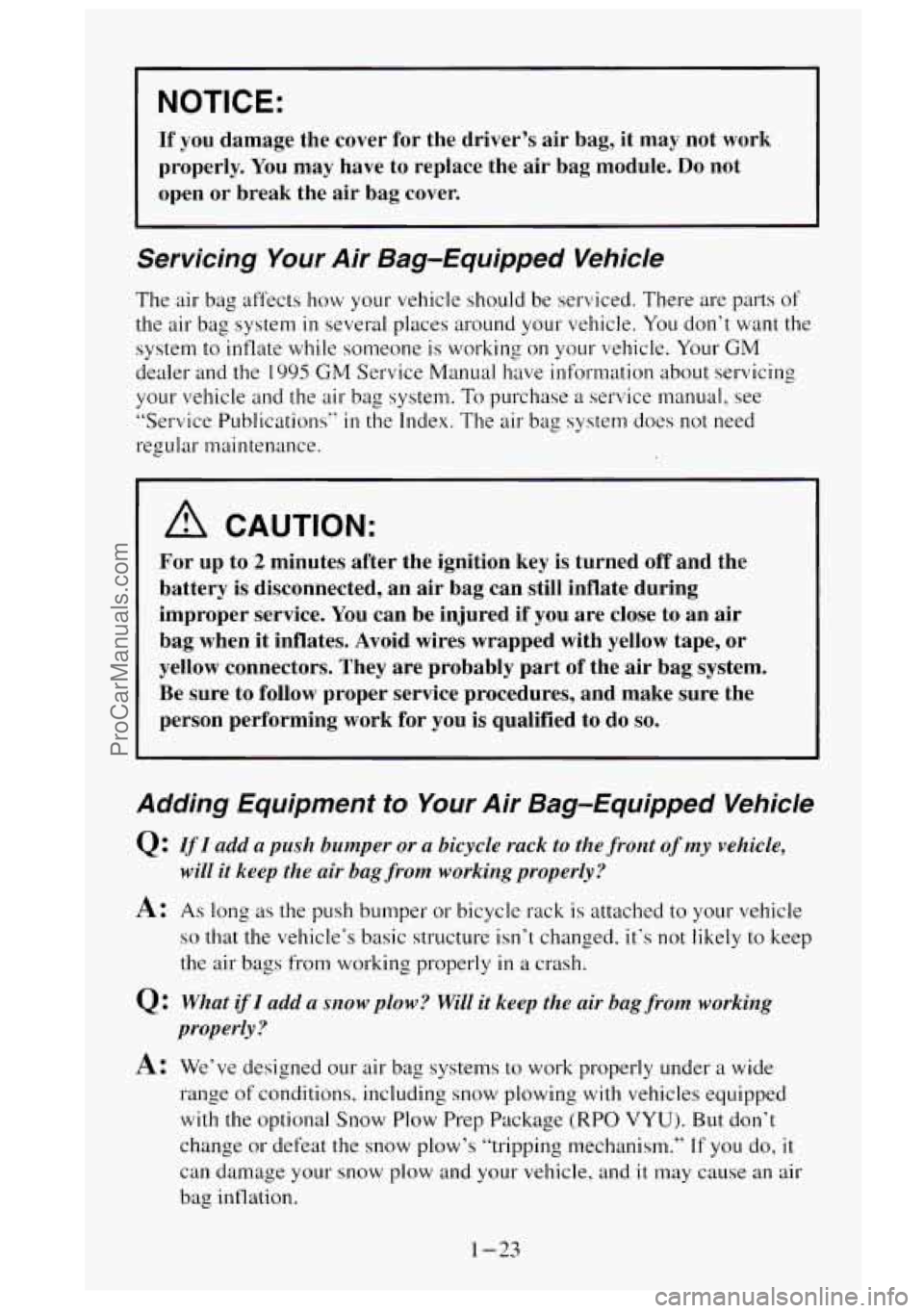
NOTICE:
If you damage the cover for the driver’s air bag, it may not work\
properly. You may have to replace the air bag module.
Do not
open or break the air bag cover.
Servicing Your Air Bag-Equipped Vehicle
The air bag affects how your vehicle should be serviced. There are parts of
the air bag system in several places around your vehicle. You don’t want the
system to inflate while someone is working on your vehicle. Your
GM
dealer and the 1995 GM Service Manual have information about servicing
your vehicle and the air bag system. To purchase
a service manual, see
”Service Publications”
in the Index. The air bag system does not need
regular maintenance.
A CAUTION:
For up to 2 minutes after the ignition key is turned off and the
battery is disconnected, an air bag can still inflate during
improper service.
You can be injured if you are close to an air
bag when it inflates.
Avoid wires wrapped with yellow tape, or
yellow connectors. They are probably part of the air bag system.
Be sure to follow proper service procedures, and make sure the
person performing work for you
is qualified to do so.
Adding Equipment to Your Air Bag-Equipped Vehicle
Q: If I add a push bumper or a bicycle rack to the front of my vehicle,
will it keep the air bag from working properly?
A: As long as the push bumper or bicycle rack is attached to your vehicle
so that the vehicle‘s basic structure isn’t changed. it‘s not likely to keep
the air bags from working properly
in a crash.
Q: What if I add a wow plow? Will it keep the air bag from working
properly?
A: We’ve designed our air bag systems to work properly under a wide
range
of conditions. including snow plowing with vehicles equipped
with the optional Snow Plow Prep Package
(RPO VYU). But don’t
change or defeat the snow plow’s “tripping mechanism.”
If you do, it
can damage your snow plow and your vehicle, and it may cause an air
bag inflation.
1-23
ProCarManuals.com
Page 63 of 488
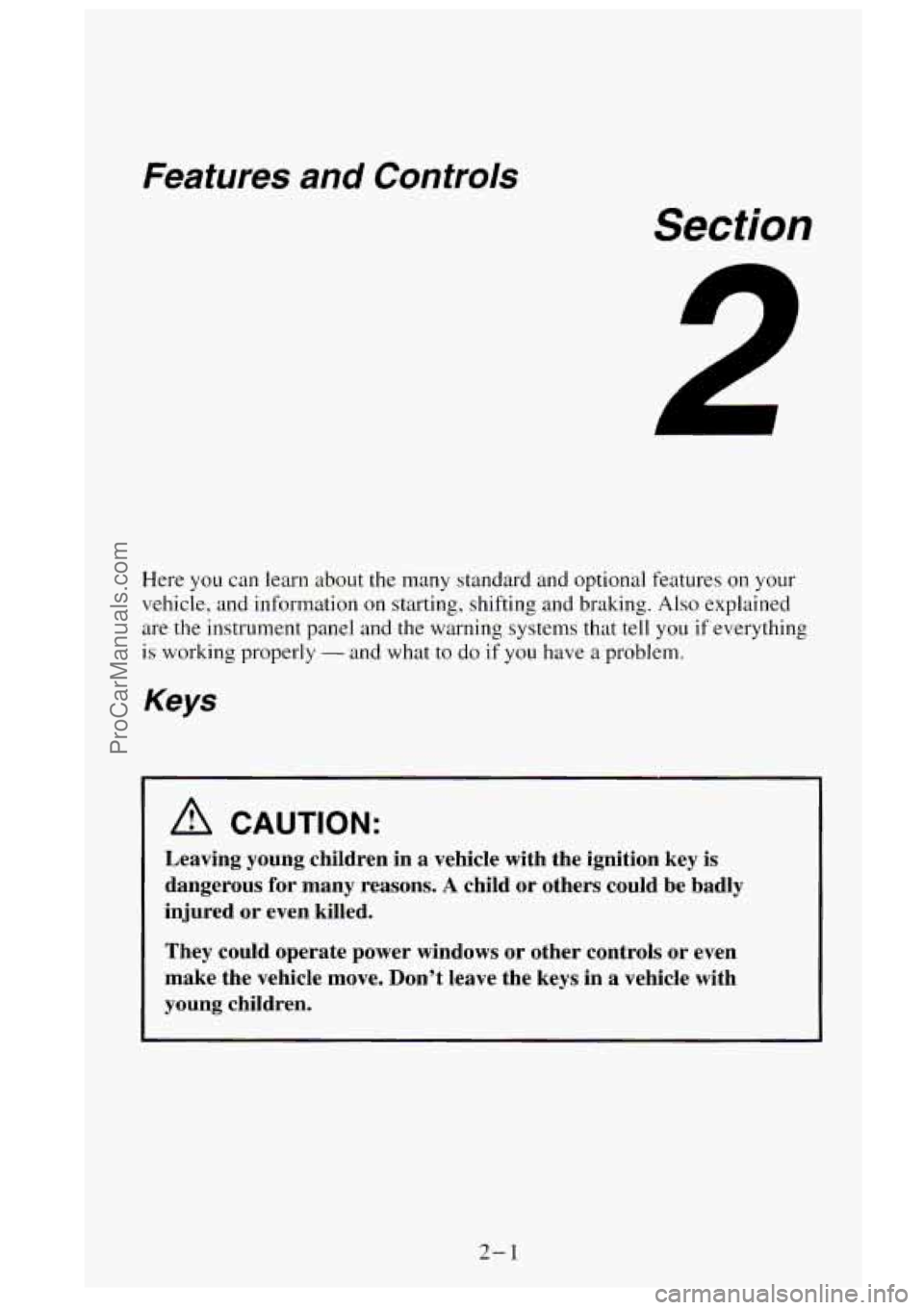
Features and Controls
Section
Here you can learn about the many standard and optional features on your
vehicle, and information on starting, shifting and braking. Also explained
are the instrument panel and
the warning systems that tell you if everything
is working properly - and what to do if you have a problem.
Keys
t
A CAUTION:
Leaving young children in a vehicle with the ignition key is
dangerous for many reasons.
A child or others could be badly
injured
or even killed.
They could operate power windows or other controls
or even
make the vehicle move. Don’t leave the keys in a vehicle with
young children.
2- 1
ProCarManuals.com
Page 64 of 488
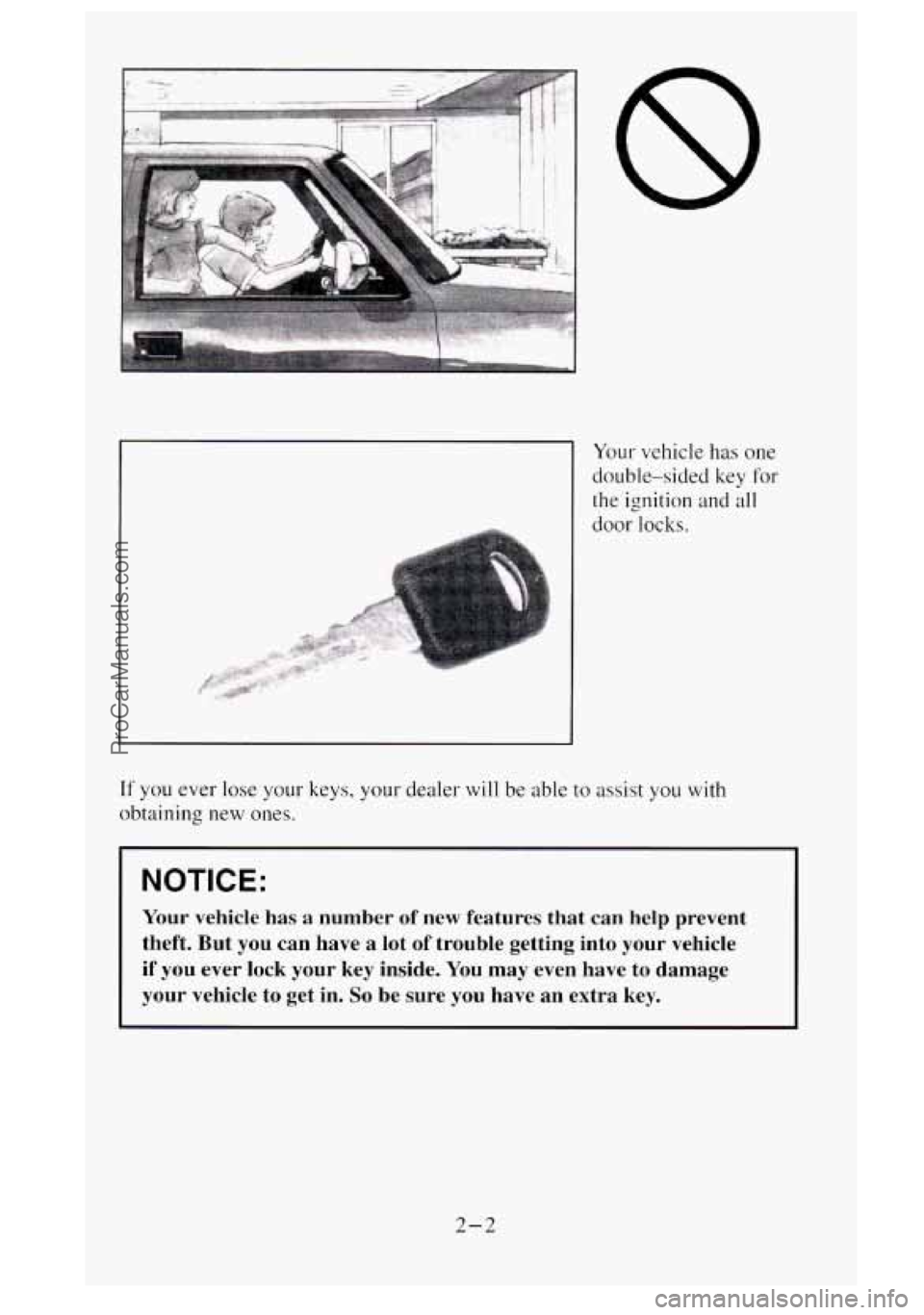
Your vehicle has one
double-sided key
for
the ignition and all
door locks.
If you ever lose your keys, your dealer will be able to assist you with
obtaining new ones.
I NOTICE:
Your vehicle has a number of new features that can help prevent
theft. But you can have a lot of trouble getting into your v\
ehicle
if
you ever lock your key inside. You may even have to damage
your vehicle to get in.
So be sure you have an extra key.
2-2
ProCarManuals.com
Page 69 of 488
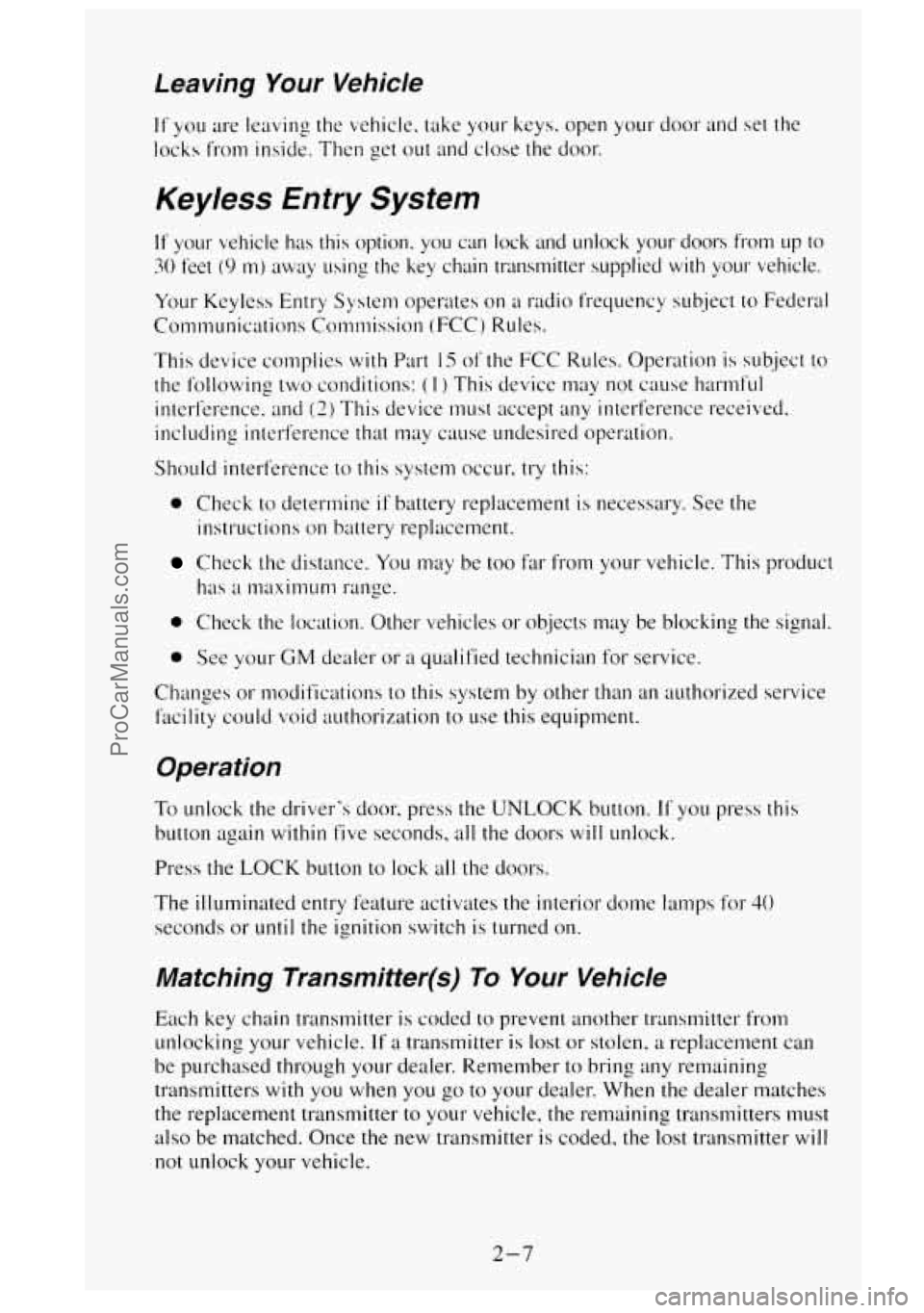
Leaving Your Vehicle
It' you are leaving the vehicle. take your keys. open your door and set the
locks from inside. Then get out
and close the door.
Keyless Entry System
If your vehicle has this option. you can lock and unlock your doors from up to
30 feet (9 m) away usins the key chain transmitter supplied with your vehicle.
Your Keyless
Entry System operates on ;I radio frequency subject to Federal
Communications Commission (FCC)
Rules.
This device complies with Part IS of the FCC Rules. Operation is subject to
the following two conditions: ( I ) This device may not cause harmful
interference. and
(2) This device must accept any interterence received,
including interference that may
C~LIS~ undesired operation.
Should interference to
this system occur. try this:
0 Check to determine if battery replacement is necessary. See the
instructions
on battery replacement.
Check the distance. You nay be too far from your vehicle. This product
has
a maximum range.
0 Check the location. Other vehicles or objects may be blocking the signal
0 See your GM dealer or a qualified technician for service.
Changes or modifications to this system by other than an authorized service
facility could void authorization
to use this equipment.
Operation
To unlock the driver's door. press the UNLOCK button. If you press this
button again within five seconds, all the doors will unlock.
Press the
LOCK button to lock all the doors.
The illuminated entry feature activates the interior dome lamps
for 40
seconds or until the ignition switch is turned on.
Matching Transmitter(s) To Your Vehicle
Each key chain transmitter is coded to prevent another transmitter from
unlocking your vehicle.
If a transmitter is lost or stolen. a replacement can
be purchased through your dealer. Remember to bring any remaining
transmitters with you when
you go to your dealer. When the dealer matches
the replacement transmitter
to your vehicle, the remaining transmitters must
also be matched. Once the new transmitte.r is coded, the
lost transmitter will
not unlock your vehicle.
2-7
ProCarManuals.com
Page 71 of 488
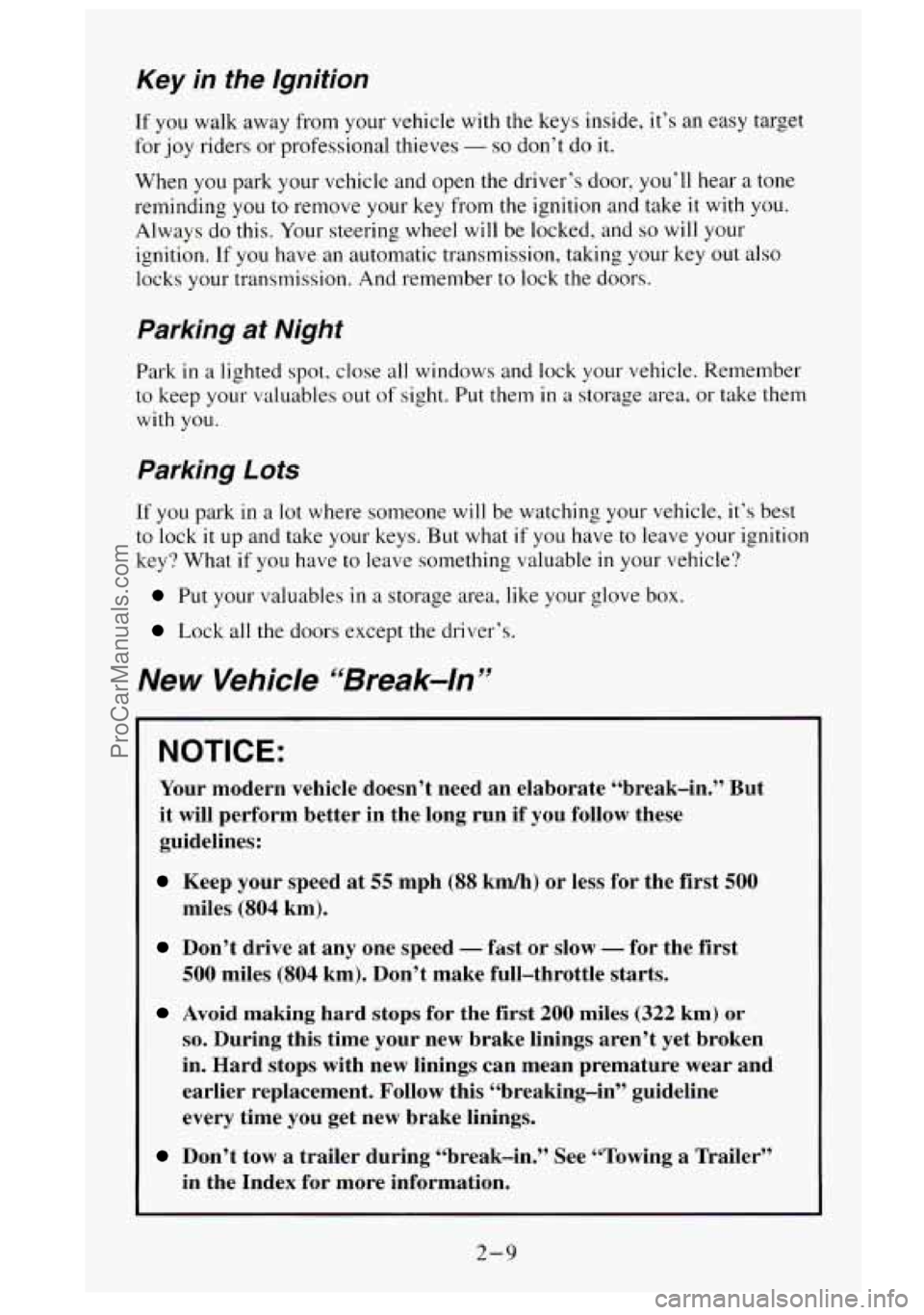
Key in the Ignition
If you walk away from your vehicle with the keys inside, it’s an easy target
for joy riders or professional thieves
- so don’t do it.
When you park your vehicle and open the driver’s door, you‘ll hear a tone
reminding
you to remove your key from the ignition and take it with you.
Always do this.
Your steering wheel will be locked, and so will your
ignition. If you have
an automatic transmission, taking your key out also
locks your transmission. And remember to lock the doors.
Parking at Night
Park in a lighted spot, close all windows and lock your vehicle. Remember
to keep
your valuables out of sight. Put them in a storage area, or take them
with
you.
Parking Lots
If you park in a lot where someone will be watching your vehicle, it‘s best
to lock
it up and take your keys. But what if you have to leave your ignition
key? What if
you have to leave something valuable in your vehicle?
Put your valuables in a storage area, like your glove box.
Lock all the doors except the driver’s.
New Vehicle “Break-In ”
NOTICE:
Your modern vehicle doesn’t need an elaborate “break-in.” But
it will perform better in the long run if you follow these
guidelines:
Keep your speed at 55 mph (88 km/h) or less for the first 500
miles (804 km).
Don’t drive at any one speed - fast or slow - for the first
500 miles
(804 km). Don’t make full-throttle starts.
Avoid making hard stops for the first 200 miles (322 km) or
so. During this time your new brake linings aren’t yet broken
in. Hard stops with new linings can mean premature wear and
earlier replacement. Follow this “breaking-in” guideline
every time you get new brake linings.
Don’t tow a trailer during “break-in.” See “Towing a Trailer”
in the Index
for more information.
2-9
ProCarManuals.com
Page 72 of 488
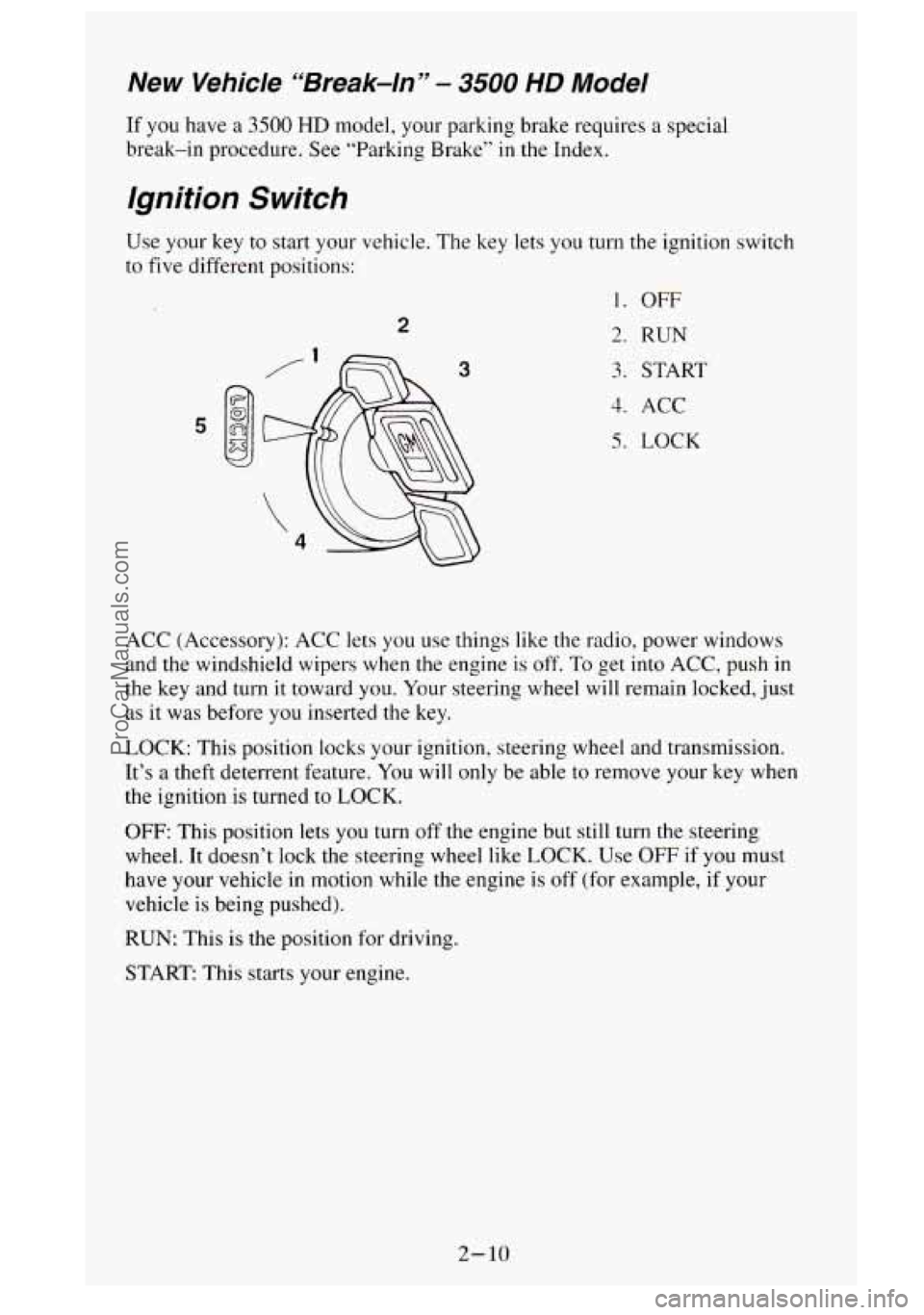
New Vehicle “Break-In” - 3500 HD Model
If you have a 3500 HD model, your parking brake requires a special
break-in procedure. See “Parking Brake”
in the Index.
Ignition Switch
Use your key to start your vehicle. The key lets you turn the ignition switch
to five different positions:
2
5
1. OFF
2. RUN
3. START
4. ACC
5. LOCK
ACC (Accessory):
ACC lets you use things like the radio, power windows
and the windshield wipers when the engine is off. To get into ACC, push in
the key and turn it toward you. Your steering wheel will remain locked, just
as it was before you inserted the key.
LOCK: This position locks your ignition, steering wheel and transmission.
It’s
a theft deterrent feature. You will only be able to remove your key when
the ignition
is turned to LOCK.
OFF: This position lets you turn off the engine but still turn the steering
wheel. It doesn’t lock the steering wheel like LOCK. Use
OFF if you must
have your vehicle
in motion while the engine is off (for example, if your
vehicle is being pushed).
RUN: This is the position for driving.
START: This starts your engine.
2- 10
ProCarManuals.com
Page 73 of 488
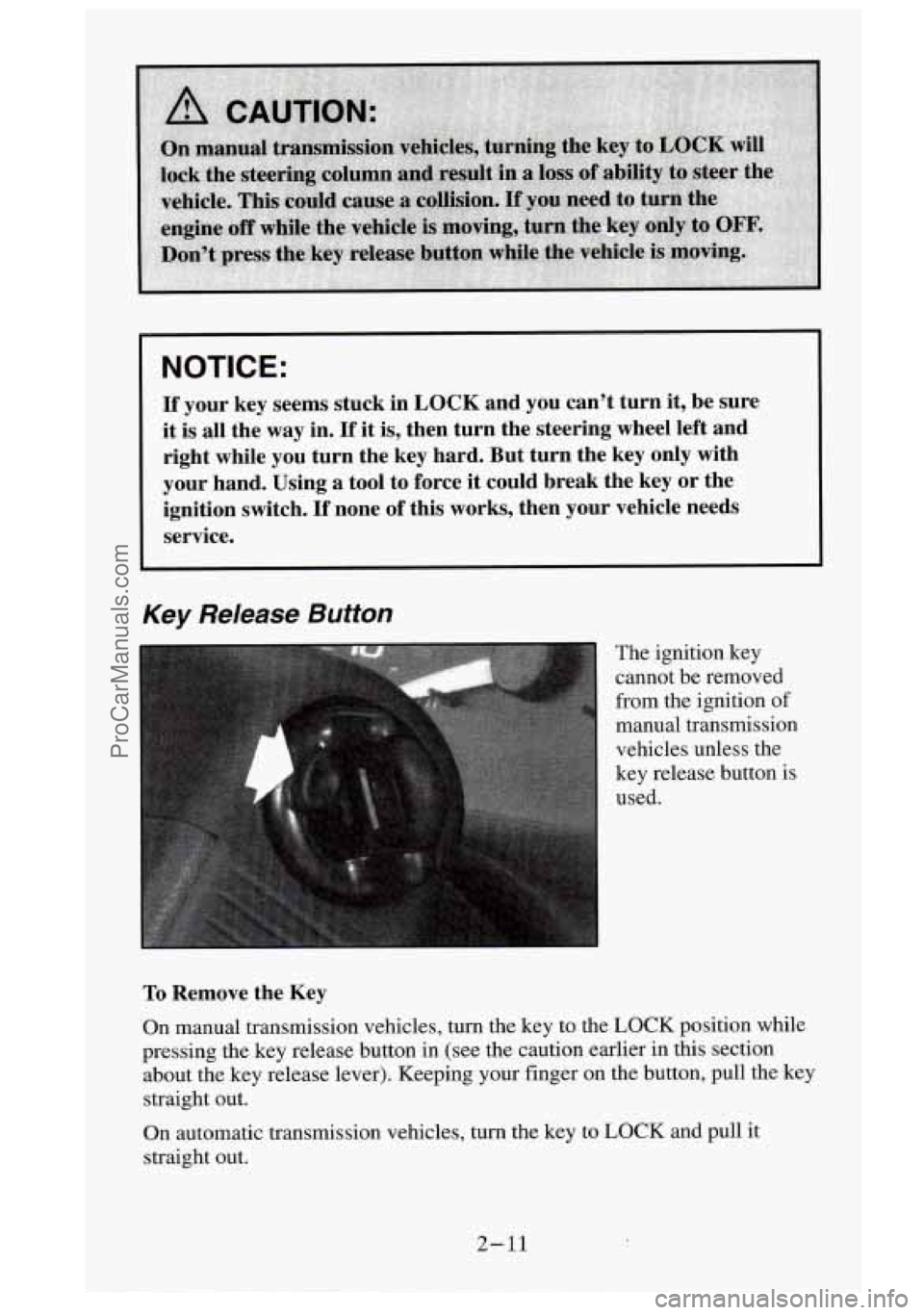
ITICE:
If your key seems stuck in LOCK and you can’t turn it, be sure
it is all the
way in. If it is, then turn the steering wheel left and
right while you turn the key hard. But turn the key only with
your hand. Using
a tool to force it could break the key or the
ignition switch.
If none of this works, then your vehicle needs
service.
Key Release Button
The ignition key cannot be removed
from the ignition
of
manual transmission
vehicles unless the
key release button is
used.
To Remove the Key
On manual transmission vehicles, turn the key to the LOCK position while
pressing the key release button in (see the caution earlier i\
n this section about the key release lever). Keeping your finger on the butt\
on, pull the key straight out.
On automatic transmission vehicles,
turn the key to LOCK and pull it
straight cwt.
2-11
ProCarManuals.com
Page 74 of 488
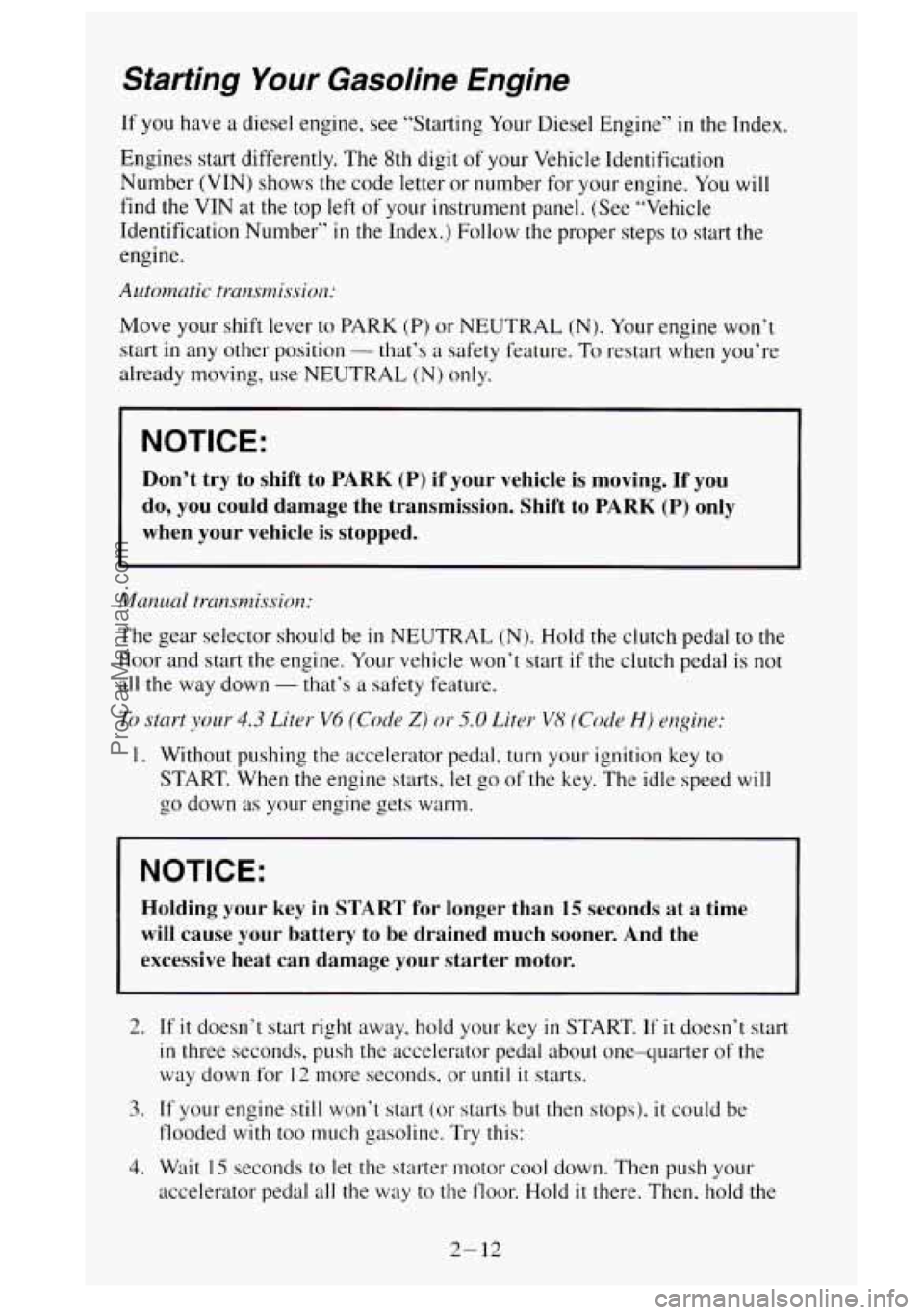
Starting Your Gasoline Engine
If you have a diesel engine, see “Starting Your Diesel Engine” in the Index.
Engines start differently. The 8th digit of your Vehicle Identification
Number (VIN) shows the code letter or number for your engine.
You will
find the
VIN at the top left of your instrument panel. (See “Vehicle
Identification Number”
in the Index.) Follow the proper steps to start the
engine.
Automatic trunsnaission:
Move your shift lever to PARK (P) or NEUTRAL (N). Your engine won’t
start
in any other position - that’s a safety feature. To restart when you’re
already moving, use NEUTRAL
(N) only.
NOTICE:
Don’t try to shift to PARK (P) if your vehicle is moving. If you
do, you could damage the transmission. Shift to
PARK (P) only
when your vehicle
is stopped.
The gear selector should be in NEUTRAL (N). Hold the clutch pedal to the
floor and start the engine. Your vehicle won’t start
if the clutch pedal is not
all the way down
- that’s a safety feature.
To start ymr 4.3 Liter V6 (Code Z) or 5.0 Liter V8 (Code H) engine:
1. Without pushing the accelerator pedal, turn your ignition key to
START. When the engine starts, let go of the key. The idle speed will
go down as your engine gets warm.
NOTICE:
Holding your key in START for longer than 15 seconds at a time
will cause your battery to be drained much sooner. And the
excessive heat can damage your starter motor.
2. If it doesn’t start right away, hold your key in START. If it doesn’t start
in three seconds, push the accelerator pedal about one-quarter of the
way down for
12 more seconds, or until it starts.
3. If your engine still won’t start (or starts but then stops), it could be
flooded
with too much gasoline. Try this:
4. Wait 15 seconds to let the starter motor cool down. Then push your
accelerator pedal all the way to the floor. Hold
it there. Then, hold the
2- 12
ProCarManuals.com